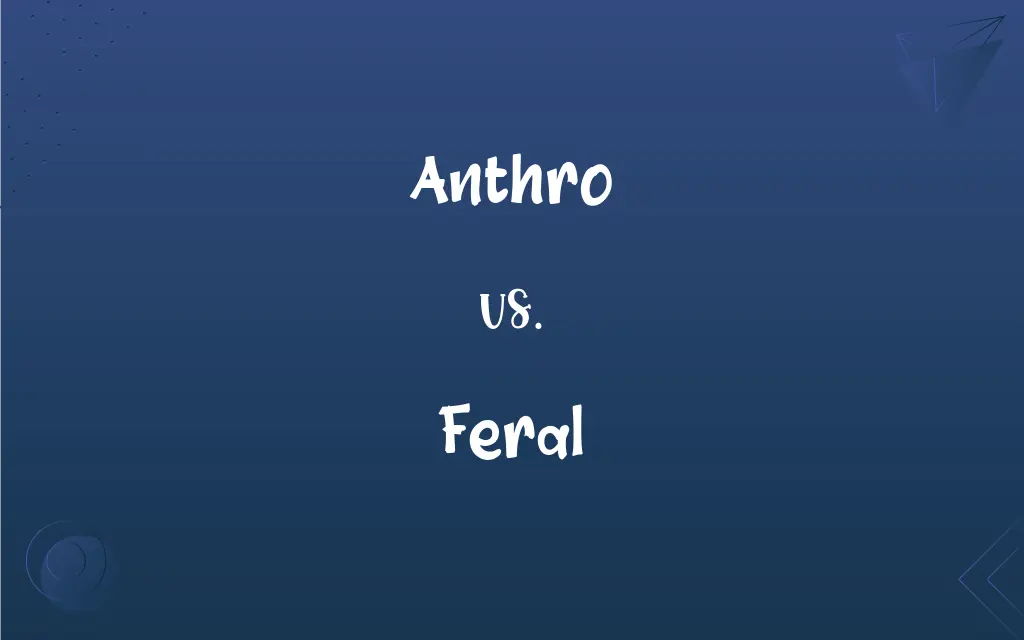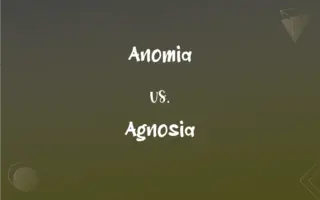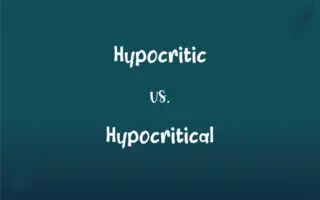Anthro vs. Feral: What's the Difference?
Edited by Aimie Carlson || By Harlon Moss || Updated on November 6, 2023
"Anthro" refers to anthropomorphic, where animals have human traits; "feral" describes a wild state, especially of domesticated animals gone wild.

Key Differences
"Anthro," short for anthropomorphic, describes animals or objects that are given human characteristics, like the ability to speak, walk upright, or express human emotions. In contrast, "feral" refers to an animal that has escaped domestication and reverted to a wild state. While an anthro character in a story might drive a car or wear clothes, a feral animal would shun human contact and survive through its natural instincts.
In the context of character design, "anthro" characters are often depicted in various forms of human-like media, such as cartoons or video games, showcasing human intelligence and social structures. "Feral" characters, however, are portrayed with more animalistic behaviors and are typically shown living in the wild, adhering to the natural order of their species without any human societal influences.
When discussing fictional works, an "anthro" character could be a talking wolf that walks on two legs and engages in human-like activities. In the same narrative, a "feral" wolf would behave as a normal wolf would in nature, hunting for food and potentially avoiding any human interaction. The key distinction lies in the level of human attributes present in the anthro character versus the lack thereof in the feral animal.
In art and literature, "anthro" is often associated with fantasy or whimsical genres that explore themes beyond the limits of reality. In contrast, "feral" may be used in more serious or realistic contexts, emphasizing the primal and untamed aspects of nature. An anthro character might explore complex human emotions, while a feral creature's narrative would focus on survival and innate behaviors.
It's also worth noting that while "anthro" characters can exist only in the realm of fiction and human imagination, "feral" is a term used in real life to describe actual animals. Anthro animals are constructs that blend human and non-human elements creatively, whereas feral animals are very much a part of our natural world.
ADVERTISEMENT
Comparison Chart
Definition
Animals with human characteristics
Domesticated animals reverted to wild
Representation
Human-like behavior and culture
Wild, survival behavior
Usage in Fiction
Common in fantasy and cartoons
Used in realistic or survival contexts
Physical Attributes
Often bipedal, can have human attire
Quadrupedal, natural appearance
Interaction with Humans
Often depicted interacting with humans
Typically avoids human contact
ADVERTISEMENT
Anthro and Feral Definitions
Anthro
In fandoms, characters or creatures that exhibit human intelligence and society.
The convention had a section dedicated to anthro fan art.
Feral
Existing in a natural state, as opposed to a domesticated or cultivated state.
The island has a population of feral horses.
Anthro
Relating to the study of human beings ('anthro' as a prefix).
She's taking an anthro class that focuses on cultural practices.
Feral
The process by which a domestic animal returns to the wild.
Feralization has made the pigeons less dependent on humans.
Anthro
In art, a depiction of an animal with human-like posture or expressions.
His favorite cartoon features an anthro rabbit as the hero.
Feral
An animal that was once domesticated but now lives in the wild.
The feral cat has adapted to life without human caretakers.
Anthro
Short for anthropomorphic, meaning ascribing human traits to non-human entities.
The anthro fox character in the game wore a detective's outfit.
Feral
Wild or untamed, often used to describe aggressive behavior.
The dog's feral growl warned off the intruders.
Anthro
Pertaining to blending human characteristics into design, such as in robotics.
The anthro robot was designed to mimic human facial expressions.
Feral
Someone or something that is fierce, savage, or relentless.
He fought with a feral intensity.
Feral
Having returned to an untamed state from domestication
A pack of feral dogs.
Feral
Existing in a wild or untamed state.
FAQs
Can "anthro" apply to objects?
Yes, "anthro" can be used to describe inanimate objects with human traits in art or literature.
Are feral animals dangerous?
Feral animals can be unpredictable and may be more cautious or aggressive towards humans.
Can feral animals be tamed again?
It's challenging to tame feral animals, especially if they've been wild for a long time.
What does "anthro" stand for?
"Anthro" is short for anthropomorphic, which means having human characteristics.
What does "feral" mean?
"Feral" refers to an animal that was once domesticated but has returned to a wild state.
Is "anthro" a genre?
"Anthro" can describe a genre of media where anthropomorphic characters are central.
How are anthro characters created?
Anthro characters are created by artists and writers who combine human and animal elements.
Do anthro characters exist in real life?
No, anthro characters are fictional and exist in creative media.
Are all anthro characters animals?
Typically, yes, though the concept can extend to any non-human entity with human traits.
Are feral animals the same as wildlife?
Not exactly; feral animals have domesticated ancestry, whereas wildlife has always been wild.
How does an animal become feral?
Animals become feral by living and reproducing in the wild after escaping captivity.
What is a feral child?
A feral child is a human child who has lived isolated from human contact and behaves in a wild manner.
Can feral animals revert to being pets?
It's rare and usually requires extensive rehabilitation.
Can a pet become feral?
Yes, if a domesticated pet is abandoned or escapes, it can become feral.
Is "anthro" used in science?
"Anthro" can be a prefix in anthropology but is not used to describe scientific processes.
Do feral animals live in groups?
Some feral animals may form groups, while others live solitary lives.
Can feral animals survive in urban areas?
Yes, some feral animals adapt well to urban environments.
Can "anthro" refer to robots?
Yes, if the robots have human-like features, they can be described as anthro.
Are anthro characters always based on real animals?
They can be based on real or mythical animals, or entirely invented species.
Is an anthro character the same as a mascot?
Not necessarily; mascots can be anthro characters, but not all anthro characters are mascots.
About Author
Written by
Harlon MossHarlon is a seasoned quality moderator and accomplished content writer for Difference Wiki. An alumnus of the prestigious University of California, he earned his degree in Computer Science. Leveraging his academic background, Harlon brings a meticulous and informed perspective to his work, ensuring content accuracy and excellence.
Edited by
Aimie CarlsonAimie Carlson, holding a master's degree in English literature, is a fervent English language enthusiast. She lends her writing talents to Difference Wiki, a prominent website that specializes in comparisons, offering readers insightful analyses that both captivate and inform.































































